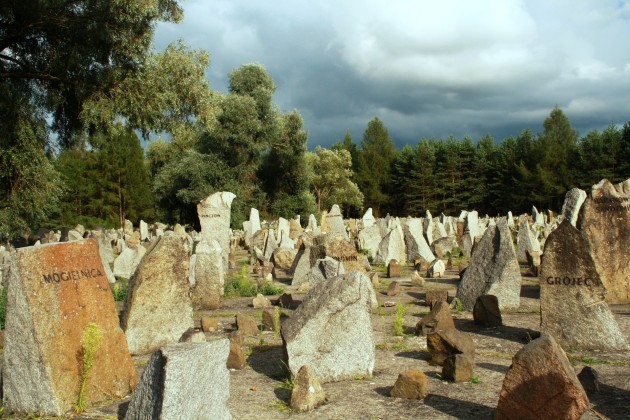The Lilith Blog 1 of 2
June 28, 2017 by Chloe Rose Stuart-Ulin
Memorials versus Modern Jewish Life in Poland
 In May I visited Treblinka with a small group of Global Leadership fellows. We arrived at the extermination camp in the evening, the only people there, to silence and swarming mosquitos.
In May I visited Treblinka with a small group of Global Leadership fellows. We arrived at the extermination camp in the evening, the only people there, to silence and swarming mosquitos.
Treblinka was a gravel mine before the Nazis took it over in 1940. The pits and mounds of the tunnels are still visible, though now covered by grass. As are the train tracks that transported the gravel away, and then the humans towards. The vast field of grass is ringed with trees and interrupted every so often by enormous, right-angle stones, nearly as tall as a person. They’re jagged and imposing, seemingly placed at random along the path.
Then all at once you turn a corner, the only corner past the trees, and the full scale of the memorial comes into view: 17,000 more stones, standing in clusters, with an eight-meter high monument of flat grey stone at the center. Carved across the top are terrified faces, eyes open, surrounded by other forms left featureless. Above them two hands reach upwards to the sky; a final impression of being buried alive.
In the summer of 2015 I worked full time at a Holocaust Education Centre. I listened to and summarized over 120 hours of recorded witness testimony, gathered from survivors living in Canada. It was my job to find each story’s unique qualities and identify them for possible exhibitions. Polish testimonies were the most horrifying, with the most time dedicated to the camps. I would avoid transcribing them for weeks. It would take me over a year to write about the experience for Lilith’s Spring 2017 issue.
At Treblinka, I wondered at the labor it must have taken to construct such an obscene place, and the labor of bringing our little group out here to see it. How many people must pass through every day for the bouquets to remain fresh, to account for every clean flag of Israel, poking out of the ground, jammed between the rocks, draped deliberately over trees.
Our group didn’t visit these sites as tourists, or with the intention of villainizing Poland. We came only as witnesses to the memorial sites and camps, and to the growing Jewish community in Warsaw and Krakow. We visited local JCCs, none more than nine years old, where young Polish Jews fight to have their heritage recognized by their peers and government. Most Jews in Poland do not find out that they’re Jewish until well into adulthood, when parents or grandparents finally feel safe enough to reveal the truth. Our guide at the Warsaw JCC told us that deathbed confessions are not uncommon.
JCC Krakow, the older of the two, hangs brightly colored posters around the city with caricature dreidels and challah bread. “Did your Grandfather ever play with this?” is printed next to the dreidel, and “Did your Grandmother ever bake this for you?” beside the challah. “Come see us!” they say at the bottom, indicating the JCC’s center-city address. Other posters show Hebrew letters and other paraphernalia, anything that might provoke some déjà vu and begin the process of questioning. Those who chose to embrace their ancestry have created a small and shockingly pure bubble of Jewish culture in modern-day Poland; a spectacular thing to witness after my work with testimony.
On the last day of our trip, we were asked to list the challenges facing the Jewish communities in Poland today, and to propose solutions. The question was frustrating and personal. Our little group debated for over an hour. Whose job is it to preserve these places and memories when there are no more survivors left to advocate their legitimacy? Holocaust memorials like Treblinka are necessary pilgrimage routes, where young adults are encouraged to come and test their resolve to create a better world, no matter their heritage.
The stones at Treblinka evoked in me some deep-seated terror, a creeping discomfort I felt when I tried to engage. We’d been specifically chosen to come here, handpicked from a pool of impressive applicants from all over the world, but our emotional response as a group was muted, directionless. I placed my hand over a tiny stone to my right and felt awkward.
Of those who survived Treblinka and the other death camps in Poland, there are only a handful still alive and able to testify to their experiences. In my work at the Holocaust Education Center, I noticed that survivors admitted regularly that they would tell their story only once, for the tape, and never speak of it again. Some asked us to release the tape only after their death.
Our guide for Treblinka crossed the field ahead of us. Around the monument and behind it, some stones bear the names of towns, Jewish towns in Poland that no longer exist. She crouched at the base of one in particular, too far away for me to see the name, and lit a candle. We left an hour later, well after dark.
Chloe Rose Stuart-Ulin is a Canadian/American writer based in Montreal, Canada. Her nonfiction work has appeared internationally for Ha’aretz (Israel) and Macleans (Canada), Lilith and The American Pilgrims Association (U.S.). She is a graduate of the BFA Creative Writing program at the University of British Columbia.
The views and opinions expressed in this article are the author’s own and do not necessarily reflect those of Lilith Magazine.
 Please wait...
Please wait...